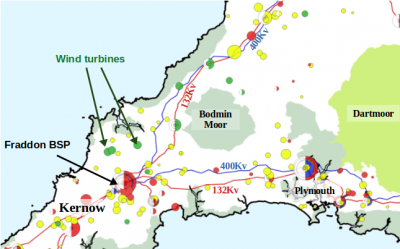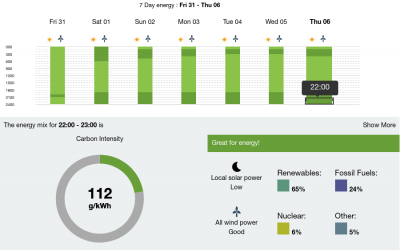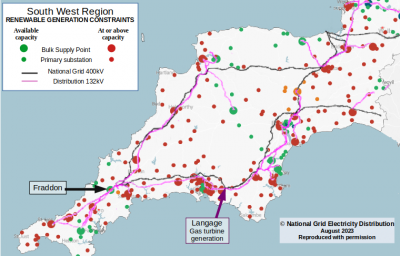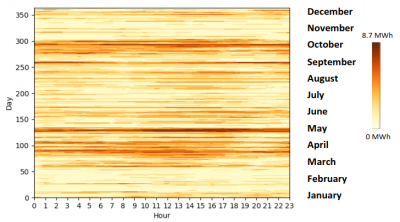Comparing & Evaluating the Efficiency of Gas Heating vs. ASHP Powered by Gas-Fired Electricity
Allow me to post a hypothesis...
It's possible that 'we' discard renewable generation in order to keep gas-generation plants operating in combined cycle mode overnight. But I'm not yet sure how to verify that.
Allow me to use my own region to illustrate this. It makes life simpler because it's a peninsula, and the source of electricity is therefore much easier to trace.
Here's a snapshot of the Connected Large Generation sites from last year...
Fraddon is a Bulk Supply Point (BSP) which takes the electricity generated by those onshore wind-farms I've identified on the north Cornwall coast.
Here's where a BSP sits in the Distribution Grid hierarchy of voltages:
Since we've had a lot of wind from the north during the last week, you'd expect these wind-turbines to be generating lots both day & night.
We can see that my looking at the statistics for Fraddon itself over that time:
The lower-half of that graphic displays the actual situation between 22:00 - 23:00 last night (Thurs 6th June) because that's the time period I clicked on. I want to ensure I'm selecting a time when there's no solar generation for the purposes of this exercise.
Let me now expand that to see a breakdown of generation types behind the Renewables and Fossil Fuels labels:
And that raises an interesting question as to why Fraddon would need any electricity from a gas generation plant last night?!
Let's just see where that gas generation site is:
Is it possible that the Gas Turbine generators at Langage, east of Plymouth, are reducing the amount they charge for electricity at night, such that it costs less to buy than the Zero-Carbon output from the Cornish wind-turbine sites?
Such a move would allow the gas-turbine generators to remain operating in closed-cycle mode instead of shutting down overnight.
Here's another graph which might shed some light on this:
It shows an 'illustrative' ANM plot which would apply if I was wanting to connect a commercial battery storage (BESS) plant to the Distribution Grid in the vicinity of Fraddon. ANM is Automated Network Management, which reduces the amount of power that may be fed to the grid during times of excess generation.
The graph shows time of day (x-axis) against day of the year (y-axis).
The darker the colour, the less electricity I would be able to export to the grid.
That ANM plot is typical of a location where the dominant generation is from wind.
And if we're 'discarding' wind generation in the Fraddon area because there's over-supply, then why would there be the need for any electricity derived from a gas-turbine plant 50-miles away? We should be seeing the night-time energy-mix at Fraddon to be almost exclusively from those nearby wind-turbines, wouldn't we?
Save energy... recycle electrons!
If the electricity supply industry and grid was still state owned, then renewable generation make take precedence over other forms of generation, but that is no longer the case. Owners of gas fired power stations may therefore find it more cost effective to supply electrical energy at cost or slightly below cost rather than shutting down for several hours during low demand periods.
The grid and distribution operators have to balance supply to demand, and to be able to do so they must have a percentage of the overall supply which they can call upon to increase or reduce generation in a controlled manner. At the moment this is normally gas fired power stations. There must be some controlled generation operating to be able to balance the changes in supply from renewable sources.
That is a well-reasoned and persuasive argument, @transparent. I'd guess we'd need an insider to confirm that, of course, but what you say certainly hangs together.
Is it possible to get a dataset of price per MW per generator over time for each power source in the UK? I feel sure a bit of data mining could reveal quite a lot....
105 m2 bungalow in South East England
Mitsubishi Ecodan 8.5 kW air source heat pump
18 x 360W solar panels
1 x 6 kW GroWatt battery and SPH5000 inverter
1 x Myenergi Zappi
1 x VW ID3
Raised beds for home-grown veg and chickens for eggs
"Semper in excretia; sumus solum profundum variat"
My wife and I have just been out for a meal with some close friends. My friend, who works for NG, made me aware of quite an interesting fact, that the present gas distribution system transports 3 times more energy than the electricity distribution system, the later of which could be struggling to meet demand come the next Winter.
It may be time to buy a portable generator.
- 26 Forums
- 2,367 Topics
- 53.7 K Posts
- 170 Online
- 6,042 Members
Join Us!
Worth Watching
Latest Posts
-
RE: Solis S6-EH1P8K-L-PLUS – Why I Chose It and What I’ve Learned So Far
@majordennisbloodnok To be honest, when I spoke with...
By Batpred , 1 hour ago
-
RE: Changing from 4-port buffer to volumizer
@andy1618 see the very sage advice from @editor above. ...
By JamesPa , 4 hours ago
-
RE: New Fogstar 15.5kWh upright solution
The video shows the JK balancer, but the connection of ...
By Batpred , 6 hours ago
-
RE: Ecodan unable to hit legionella target temp - what's the consensus?
@9jwr9 Hi, yes this is the issue with every (stand alon...
By ASHP-BOBBA , 7 hours ago
-
RE: Help me keep the faith with my air source heat pump installation
@adamk FWIW I managed unintentionally to 'coax' mine in...
By JamesPa , 8 hours ago
-
RE: Help needed with Grant Aerona 3 issues
Ok please post back once experiment complete. Give it ...
By JamesPa , 8 hours ago
-
RE: Octopus Cosy Heat Pump Owners & Discussion Thread
You are in essence right. Adia only works with selecte...
By JamesPa , 9 hours ago
-

No, you haven’t missed out, @batpred. This thread’ll st...
By Majordennisbloodnok , 9 hours ago
-

RE: Tesla Powerwall – More of a ‘Luxury’ Than an ROI Winner!
Also, though they weren’t prepared to match the price t...
By Toodles , 10 hours ago
-
RE: How long will your energy contract last?
My INTELLI-FIX-12M-25-08-29 has less than 12 months to ...
By Batpred , 11 hours ago
-

RE: GivEnergy 2025 forthcoming batteries and inverters
Then, perhaps @toodles , you should've made a submissio...
By Transparent , 11 hours ago
-
RE: Balancing financial efficiency and comfort using the Octopus Cosy tariff
I am wondering if anyone with an EV could find the 7p/k...
By Batpred , 11 hours ago
-
Possibly, but it would also reduce DeltaT across the em...
By JamesPa , 11 hours ago
-

RE: ASHP sizing - value of Heat Transfer Coefficient
@cathoderay It was reminiscent of the BBC Open Universi...
By Toodles , 12 hours ago
-
-

@morgan They are unsupervised these days, can’t get the...
By Toodles , 3 days ago
-

RE: Setback savings - fact or fiction?
Exactly. We only need to compare conditions, to decide ...
By cathodeRay , 5 days ago
-
RE: Need Help Optimising My Rushed ECO4 Install: 12kW Bosch Heat Pump
Welcome @mickamills We too have an oversized 12kW Sa...
By Old_Scientist , 5 days ago
-
RE: My Powerwall 3 Consumes 3-4 kWh/Day in Self-Consumption: Is This Normal?
@caron I can confirm that the power usage of the PW3 is...
By Old_Scientist , 5 days ago










